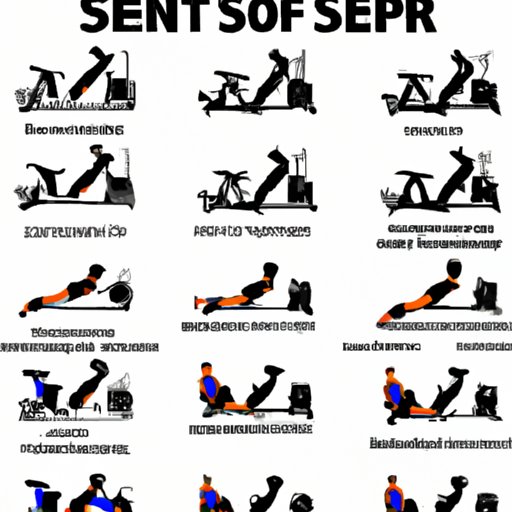Introduction
If you’re looking for a way to boost your gym performance, then you may have heard about supersets. But what exactly are they? A superset is simply two exercises that are performed back-to-back without any rest in between. It’s a great way to improve your strength and endurance, increase your metabolism, and get more done in less time. In this article, we’ll explore the benefits of supersetting in your gym workouts and provide a guide to different types of supersets.
Exploring the Benefits of Supersetting in Your Workouts
Supersets offer numerous benefits to gym-goers. Here are some of the main ones:
Improved Strength and Endurance
One of the primary benefits of supersets is improved strength and endurance. By performing two exercises back-to-back, you’re able to target the same muscle group while also pushing yourself to the limit. This helps to build muscular endurance and strength, which will make it easier to lift heavier weights and perform more reps.
Increased Metabolism
Supersets can also help to boost your metabolism. By performing multiple exercises in quick succession, you’re able to burn more calories and fat. This helps to speed up your metabolism, which in turn can lead to weight loss and increased energy levels.
Shorter Workout Time
Another great benefit of supersets is that they allow you to get more done in less time. Instead of resting between sets, you can move directly from one exercise to the next, thus reducing your overall workout time. This makes it easier to fit in a full-body workout even when you’re short on time.

How to Incorporate Supersets into Your Routine
Now that you know the benefits of supersets, let’s take a look at how to incorporate them into your routine. Here are some tips to help you get started:
Plan Out Your Supersets
Before you start your workout, it’s important to plan out which exercises you’ll be doing in each superset. You should choose exercises that target the same muscle group, or opposing muscle groups if you want to work both sides of your body. It’s also important to pick exercises that will challenge you and help you reach your goals.
Start with a Warm-up
Before you begin your superset, it’s important to warm up your muscles. This will help to reduce the risk of injury and ensure that your muscles are prepared for the workout. A few minutes of light cardio or dynamic stretching can do the trick.
Take Rest Periods Between Sets
Even though it’s called a superset, it’s still important to take rest periods between sets. This will give your muscles time to recover and prepare for the next set. Aim for 30 seconds to 1 minute of rest between sets.
Monitor Your Progress
Lastly, it’s important to monitor your progress and adjust your supersets as needed. Keep track of how many reps and sets you’re doing and don’t be afraid to switch up your exercises if you’re not seeing the results you want. This will help to ensure that you’re always challenging yourself and getting the most out of your workouts.

A Guide to Different Types of Supersets
There are several different types of supersets that you can use to vary up your workouts. Here’s a quick guide to some of the most popular options:
Opposing Muscle Groups
This type of superset involves pairing two exercises that target opposing muscle groups. For example, you could pair a chest press with a bent-over row. This type of superset allows you to work both sides of your body without taking any rest.
Same Muscle Groups
This type of superset involves pairing two exercises that target the same muscle group. For example, you could pair a barbell curl with a dumbbell curl. This type of superset allows you to work the same muscle group in different ways, which can help to increase strength and muscular endurance.
Pre-Exhaustion
This type of superset involves performing an isolation exercise before a compound exercise. For example, you could pair a bicep curl with a chin-up. This type of superset allows you to exhaust a particular muscle group before moving onto a more challenging exercise.
Post-Exhaustion
This type of superset involves performing a compound exercise before an isolation exercise. For example, you could pair a squat with a calf raise. This type of superset allows you to exhaust a larger muscle group before moving onto a smaller, more targeted muscle group.
What Muscles Benefit Most from Supersets?
Supersets can be used to target any muscle group in the body, but there are a few muscle groups that seem to benefit most from this type of workout. Here are some of the muscles that can benefit most from supersets:
Chest and Back
Supersets are particularly effective for targeting the chest and back muscles. Pairing exercises like push-ups and pull-ups can help to strengthen and define these muscle groups.
Arms and Shoulders
Supersets can also be used to target the arms and shoulders. Pairing exercises like bicep curls and shoulder presses can help to tone and define these muscle groups.
Legs
Finally, supersets can be used to target the legs. Pairing exercises like squats and lunges can help to build strength and definition in the legs.
Conclusion
Supersets are an effective way to maximize your workout time and get more out of your gym sessions. Not only do they improve strength and endurance, but they also help to increase your metabolism and reduce your overall workout time. When incorporating supersets into your routine, it’s important to plan out your sets, take rest periods between sets, and monitor your progress. Additionally, different types of supersets can be used to target different muscle groups. By following these tips, you can make the most out of your gym workouts and get the results you’re after.
(Note: Is this article not meeting your expectations? Do you have knowledge or insights to share? Unlock new opportunities and expand your reach by joining our authors team. Click Registration to join us and share your expertise with our readers.)
